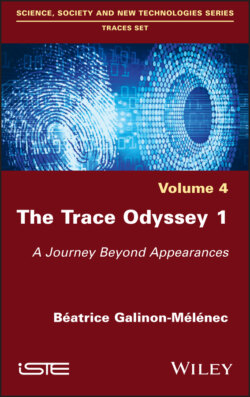Читать книгу The Trace Odyssey 1 - Beatrice Galinon-Melenec - Страница 24
I.17. Conclusion: The Trace Odyssey 1, roadmap
ОглавлениеThe Trace Odyssey relates the explorations of a 21st Century human being who, because the term trace is now used in many contexts and with very diverse intentions of meaning, and because she does not find answers to her questions in commonly used dictionaries, decided to set out to discover what the term “trace” covers and what distinguishes it from its purported synonyms.
In the course of her observations, the researcher understands that not only is the trace more complex than she had anticipated, but also, that she is a homme-trace, an Ichnos-Anthropos. The researcher then takes a new look at the concept of traces encountered in everyday life (see Chapter 1), which leads her to analyze the processes that produce them and to examine their impact(s) on the rules of digital society (see Chapter 2). Along the way, the researcher discovers new terms (corps-trace, signe-trace, anthropocentric-trace, traced processes) and older terms with contextualized use (artifact, différance58, enaction, lettrure, habitus, hypomnemata59, etc.) that enable her to enrich a vocabulary previously confined to practical life. The researcher’s interest in police investigations led her to further discoveries by testing the concepts in the search for the perpetrator of a crime. The researcher’s performance as an investigator proved to be disappointing in the eyes of the detectives who fed her imagination. The researcher then concluded that her rationality was limited and that her experience did not provide the keys of an appropriate embodied semiotics. Given this state of affairs, the researcher then joined forces with other thinkers to create a “collective intelligence” (see Chapters 4 and 5).
In summary, the trace perceived by a human being appears to be anthropocentric, in the sense that it results from relational processes between homme-trace/milieu-trace/environment-trace. A person, thus united to the world and to the complexity of the systems in which he/she is inserted, is invited to integrate this dimension of reliance60 in order to ensure responsible actions and ethical choices (see Chapter 6).
One of the systems whose construction is analyzed step by step – in Chapter 2 – is presented under the heading “Figuration of the ecosystem trace apparatus”61. Its objective is to show how:
– the interplay of successive deliberations transforms the pieces of information circulating in the digital universe and produces a more or less deliberate distortion of what has taken place;
– the human point of view, considered from their characterization as homme-trace (from Ichnos-Anthropos) – explained above – plays a pivotal role in the processes of production and in the interpretation of what is commonly referred to as “digital traces”.
The concept of homme-trace is then repositioned – in Chapter 3 – within the framework of cybersecurity, involving institutions, legal regulations and the management of online activities.
The anthropological turning point proposed in The Trace Odyssey 162, in analyzing the uses of digital technology and their consequences, appears to be all the more necessary, given that just as research applications in artificial intelligence (AI) are taking off, humans appear to forget that self-learning and autonomous machines are the result of their own creation.
Together with the study of the processes of the digital society and the analyses of the different trace systems, a new thinking emerges, positing fundamentals such as:
– the limits of certain dualisms – body/mind, culture/nature, subject/object – on which the thinking of many hommes-traces is still based;
– the adoption of a “milieu” as a way of thinking, in both senses of the term (in-between – milieu can also means “in the middle” in French – and immersion environment), which places humans in permanent interaction with their milieu;
– the denunciation of biases, resulting from the elimination of the role of the body in many analyses, particularly those related to the use of digital technology; and
– the invitation to more complex approaches placed within a dynamic ecosystem.
After the presentation of having placed some useful benchmarks to locate oneself in The Trace Odyssey 1, the first step is to discover the processes at work behind the everyday experience of a trace. This is the subject of Chapter 1.
